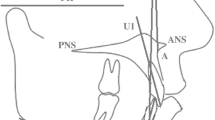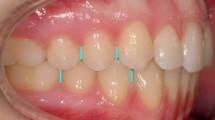Abstract
Aim: The aim of this study was to analyze the relative contribution of torque and protrusion to the change in incisor inclination in the treatment of Class II, Division 2 malocclusion with fixed appliances. Furthermore, the extent of incisor intrusion was to be evaluated. The second part of the study was aimed at documenting the stability of the therapeutic outcome in terms of inclination and intrusion within the framework of a follow-up examination.
Patients and Method: The study sample comprised 25 adult patients, and the follow-up sample eleven patients. The intrusion and change in inclination of the incisors as well as their stability were analyzed by evaluating and superimposing lateral cephalograms taken before and after treatment as well as after retention.
Results: Althout the mean value of inclination at the end of the therapy was in accordance with the standard value (102°), there was a marked interindividual variation. In the maxilla, the mean torque component was 58%, and the mean protrusion component 42%. In the mandible, the torque:protrusion ratio was 37%:63%. The mean intrusion was 1 mm in both dental arches. The follow-up examination showed that the intrusion was relatively stable. In cases where the change in inclination relapsed, the ratio of protrusion to torque was almost equal to that previously used to induce the change during the course of treatment.
Conclusion: It is concluded that therapy with torque movement and instrusion offers a more stable result in adults than protrusion movement alone.
Zusammenfassung
Ziel: Ziel der Untersuchung war es, den relativen Anteil von Torque und Protrusion an der Inklinationsveränderung der Frontzähne durch eine festsitzende Apparatur im Rahmen der Deckbissbehandlung zu bestimmen. Ebenso wurde das Ausmaß der Frontzahnintrusion festgestellt. Im zweiten Teil der Arbeit sollte im Rahmen einer Nachuntersuchung die Stabilität des Therapieergebnisses im Hinblick auf Inklination und Intrusion dokumentiert werden.
Patienten und Methode: Das Untersuchungsgut bestand aus 25 erwachsenen Patienten, die Nachuntersuchungsgruppe aus elf Personen. Anhand der Auswertung und Überlagerung von vorhandenen seitlichen Anfangs-, End- bzw. Postretentionsfernröntgenbildern wurden für die Frontzähne die Intrusion, die Inklinationsveränderung und deren Stabilität analysiert.
Ergebnisse: Der Mittelwert der Inklination am Ende der Therapie entsprach zwar der Norm (102°), variierte jedoch stark. Der Anteil an Torque betrug im Oberkiefer im Durchschnitt 58% gegenüber 42% Protrusion. Im Unterkiefer betrug das Verhältnis 37% Torque zu 63% Protrusion. Als Intrusionswerte wurden sowohl für den Ober- als auch für den Unterkiefer jeweils 1 mm ermittelt. Die Nachuntersuchung ergab, dass die Intrusion relativ stabil blieb. Trat bei der Inklinationsveränderung ein Rezidiv auf, so setzte sich dieses in annähernd dem gleichen Verhältnis Protrusion zu Torque zusammnen, mit dem zuvor diese Veränderung während der Behandlung durchgeführt wurde.
Schlussfolgerung: Dies lässt den Schluss zu, dass beim Erwachsenen eine Therapie mit Torquebewegung und Intrusion ein stabileres Ergebnis erwarten lässt als eine reine Protrusionsbewegung.
Similar content being viewed by others
Author information
Authors and Affiliations
Additional information
Received: March 12, 2001; accepted: December 6, 2001
Rights and permissions
About this article
Cite this article
Kinzel, J., Aberschek, P., Mischak, I. et al. Study of the Extent of Torque, Protrusion and Intrusion of the Incisors in the Context of Class II, Division 2 Treatment in Adults. Journal of Orofacial Orthopedics / Fortschritte der Kieferorthopädie 63, 283–299 (2002). https://doi.org/10.1007/s00056-002-0109-2
Issue Date:
DOI: https://doi.org/10.1007/s00056-002-0109-2




